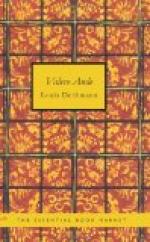According to Liljequist, individuals belong to the hybrid race when they are born of parents one of whom has blue eyes and the other brown eyes. The weaker race transmits the brown colour of its iris to the middle part of the iris of the child, while the colour of the stronger race reappears in the outer part of the iris; not, however, as pure blue, but tinted with a delicate shade of green, in consequence of the light brownish-yellowish colour which emanates from the central part.
When death is imminent, the iris displays a grayish-black, muddy gray or muddy brown colour.
The pupil of the eye is irritated in cases of nervous disease and indicates this condition. In cases where only one pupil is dilated, a local disease of the optic nerve or one side of the brain is evident. If the pupils are insensible to external irritations and remain rigid, the conclusion is that the brain or the spinal cord is badly affected.
It may be stated in a general way that clear, brilliant eyes, (when not caused by fever) are usually an indication of the good quality of the blood as well as of all other humours of the body, together with normal activity of all the central organs.
The mouth and tongue: Pathological indications manifested by the mouth are principally displayed by the lips, which are clear red in healthy people, while a hectic red indicates fever and pulmonary disease. Pale lips indicate anaemia and chlorosis, and lips of a bluish hue are signs of a generally weakened organism. Frequent, vivid contractions of the lips (usually thin in this case) indicate great nervousness.
The color of the mucous membrane of the tongue is a very fair indication of health or sickness. If a person is in health, the tongue is rosy and not coated. But any disturbance in the intestines causes a more or less coated tongue, and consequently shows the detrimental influence these particular ailments exert upon the brain and nerves. Hence, a coated tongue affords a valuable indication in making a correct diagnosis, especially in case of chronic catarrh of the stomach, this being one of the main causes of depression, and melancholia, as stated by Piderit.
The forehead, or rather the record traced thereon, in lines of nature’s unimpeachable calligraphy, warrants certain conclusions as to mentality and character; and these may be important in determining the truthfulness of the patient’s stories of suffering and other items which facilitate or impede a correct diagnosis.
The interpretation of such features, however, belongs to the realm of pure psychology, this is also true of similar conclusions drawn from the outlines of the chin.
Of much more importance for the purpose of diagnosis is the nose.
Even a child understands what the red nose of the habitual drunkard signifies. A bloated nose with a tendency to become sore is an indication of a disposition to scrofulosis.




